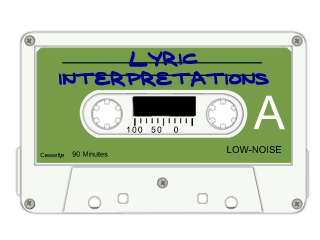All You Need Is Four Chords

Probably the greatest delusion that the public has about music is that you have to be a virtuoso to be popular. In fact, many of our famous musicians don't even read music at all! A large majority of them also only know about four chords and a couple of scales - you'd be surprised how far you can get with just that.
Take for example, the four chords of pop. If you start in the key of C-major, the chords are C-major, G-major, A-minor, and F-major. If you play them in that order, that's the pop-punk progression. Play them in a loop, and they form a plagal cadence. Or play variations on this basic structure, and you have:
- "Self Esteem" - The Offspring
- "Africa" - Toto
- "Under the Bridge" - Red Hot Chili Peppers
- "Let It Be" - The Beatles
- "Don't Stop Believin'" - Journey
- "When I Come Around" - Green Day
- "Don't Know What You Got ('Til It's Gone)" - Cinderella
- "Down Under" - Men At Work
- "With or Without You" - U2
Start from the middle and play them in this order: A-minor, F-major, C-major, G-major, and that's the "sensitive female chord progression", so-called because it's been noted that the kind of music you hear at Lilith Fair tends to use this. With this chord progression, you also have:
- "One of Us" - Joan Osborne
- "Poker Face" - Lady Gaga
- ...a lot more Offspring songs
Reverse those last two chords to: A-minor, F-major, G-major, C-major, and you have the Humoresque progression used (and named after) Antonin Dvorak's piano solo piece, and also found in:
- "So Serious" - Electric Light Orchestra
- "Crash Into Me" - Dave Matthews Band
- "Take It on the Run" - REO Speedwagon
Now shuffle them to this order: C-major, A-minor, F-major, G-major, and that's the '50s doo-wop sound. Popular in:
- "Earth Angel" - The Penguins
- "Duke of Earl" - Gene Chandler
- "Runaround Sue" and "A Teenager in Love" - Dion and the Belmonts
- "Every Breath You Take" - The Police
- "The Sign" - Ace of Base
- "Crocodile Rock" - Elton John
- "YMCA" - Village People
- "Baby" - Justin Bieber
-
"Go Cry On Somebody Else's Shoulder" - Frank Zappa
And this isn't even the tenth of it! There's dozens of possible variations, such as simply repeating one chord in the progression before moving on, or giving each chord four beats, or whatever. The fact is, pop rock and its related forms isn't designed to be very complicated music. It's designed to be so simple a kid can follow the beat.
Loop any of these or play verses based on variations of the progressions, and you've got something like half of rock and roll. If you have time, check out The Axis of Awesome's thrilling "Four Chords Song", where they stick to these four chords while playing a medley of popular songs ranging from decades of hits:

 Forgotten Weird Music Videos of the Ancient 80s | vol 2
Forgotten Weird Music Videos of the Ancient 80s | vol 2  Forgotten Weird Music Videos of the Ancient 80s | vol 1
Forgotten Weird Music Videos of the Ancient 80s | vol 1  Let’s Chase Taylor Swift Rumors
Let’s Chase Taylor Swift Rumors  When the Beatles Touched Off a Movie War
When the Beatles Touched Off a Movie War  When Mike Bloomfield Composed a Soundtrack For Andy ...
When Mike Bloomfield Composed a Soundtrack For Andy ...  Yet Another List of Bad Song Covers
Yet Another List of Bad Song Covers  Why Does Everybody Pick On Liberace?
Why Does Everybody Pick On Liberace?  Trainspotting Soundtrack Revisited : One of the Best...
Trainspotting Soundtrack Revisited : One of the Best...  Nicki Minaj and Megan Thee Stallion: Bringing Back t...
Nicki Minaj and Megan Thee Stallion: Bringing Back t...  Quirky Songs About Los Angeles
Quirky Songs About Los Angeles  Penguin Pete’s Obligatory Penguin Cafe Orchestra Post
Penguin Pete’s Obligatory Penguin Cafe Orchestra Post  Heart | How Bad Are Those Animals?
Heart | How Bad Are Those Animals?  That Time Ronnie James Dio Saved Black Sabbath’s Bacon
That Time Ronnie James Dio Saved Black Sabbath’s Bacon  What is a Left Hand Path? - Entombed and Swedish Dea...
What is a Left Hand Path? - Entombed and Swedish Dea...  Song Analysis Corner: Convoy (1975)
Song Analysis Corner: Convoy (1975)  What’s Up With Margaritaville?
What’s Up With Margaritaville?  This Album Links Duran Duran, Andy Warhol, and Kurt ...
This Album Links Duran Duran, Andy Warhol, and Kurt ...  Your Back-To-School Playlist
Your Back-To-School Playlist  Cucumber Castle | the other Bee Gees Movie
Cucumber Castle | the other Bee Gees Movie  Danny Elfman Scores New Film; Other Movie Weirdness!
Danny Elfman Scores New Film; Other Movie Weirdness!  Sparks Is Not Crying in Their Latte
Sparks Is Not Crying in Their Latte  Travis Scott : Rapper, Cannabis Entrepreneur, Filmmaker
Travis Scott : Rapper, Cannabis Entrepreneur, Filmmaker  Anders Runestad – Author and Music Blogger
Anders Runestad – Author and Music Blogger  What If They Really ARE Giants?
What If They Really ARE Giants?  Prince’s Underrated Under the Cherry Moon
Prince’s Underrated Under the Cherry Moon  Six Degrees of Blondie
Six Degrees of Blondie  Six Degrees of: Adam and the Ants
Six Degrees of: Adam and the Ants  Discovering Beat-Club | Vintage West German Music Show
Discovering Beat-Club | Vintage West German Music Show  Eurovision Contest Winners part 2
Eurovision Contest Winners part 2  Song Analysis Corner: Snoopy vs. the Red Baron | The...
Song Analysis Corner: Snoopy vs. the Red Baron | The...  Eurovision Contest Winners part 1
Eurovision Contest Winners part 1  KISS SUXX!
KISS SUXX!  You Haven’t Met Your Last Reefer Man
You Haven’t Met Your Last Reefer Man  Ruth Underwood and the “Zappa sound”
Ruth Underwood and the “Zappa sound”  Catchy Commercial Earworms | vol 2
Catchy Commercial Earworms | vol 2  Song Analysis Corner: “Trouble Every Day” | Frank Zappa
Song Analysis Corner: “Trouble Every Day” | Frank Zappa  Blues Music For Your Great Recession
Blues Music For Your Great Recession  We Can Fix America If We Just Bring Back Schoolhouse...
We Can Fix America If We Just Bring Back Schoolhouse...  Song Analysis Corner: Istanbul (Not Constantinople)
Song Analysis Corner: Istanbul (Not Constantinople)  Music To Shoot Down UFOs To
Music To Shoot Down UFOs To  Are You Ready For AI Music?
Are You Ready For AI Music?  How Dreary Was 1970s Adult Contemporary?
How Dreary Was 1970s Adult Contemporary?  I Just Called To Say Stevie Wonder's Song Deserved a...
I Just Called To Say Stevie Wonder's Song Deserved a...  "Knock On Wood" | The Real Song To Remember From Cas...
"Knock On Wood" | The Real Song To Remember From Cas...  Dr. Dre's Not Gonna Take This Anymore
Dr. Dre's Not Gonna Take This Anymore  Apache - The Shadows | A Surf-Rock Safari
Apache - The Shadows | A Surf-Rock Safari  New Year : New Music Artists You (Probably) Haven't ...
New Year : New Music Artists You (Probably) Haven't ...  Song Odyssey | I Put A Spell on You
Song Odyssey | I Put A Spell on You  KMart and S.S. Kresge | Music Mystery?
KMart and S.S. Kresge | Music Mystery?  Did I Ever Introduce You To Horrorpunk?
Did I Ever Introduce You To Horrorpunk?  Song Analysis Corner : The Coffee Song
Song Analysis Corner : The Coffee Song  Duran Duran Finally Got Inducted
Duran Duran Finally Got Inducted  That Time Taylor Swift Broke Ticketmaster
That Time Taylor Swift Broke Ticketmaster  Parody Songs and Lawsuits | Of Interest To Aspiring ...
Parody Songs and Lawsuits | Of Interest To Aspiring ...  Worst Band Spats
Worst Band Spats  Rock and Roll Bookshelf | Corey Taylor's Seven Deadl...
Rock and Roll Bookshelf | Corey Taylor's Seven Deadl...  Lizzo, the Flute, and Racist-Sexist Republican Fallout
Lizzo, the Flute, and Racist-Sexist Republican Fallout  Remembering Coolio | RIP Coolio 2022
Remembering Coolio | RIP Coolio 2022  Buy the Soundtrack, Skip the Movie : Singles (1992)
Buy the Soundtrack, Skip the Movie : Singles (1992)  Emmy Awards 2022 | Lyric Interpretations' Hot Takes
Emmy Awards 2022 | Lyric Interpretations' Hot Takes 